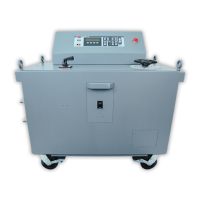I
I '
r
! I
loss
of
current will result for each inch
of
test lead. Therefore, when choosing test
leads, the length and size
of
leads chosen will determine the maximum available test
current.
It is worthwhile to sacrifice cross section
of
test leads for the sake
of
reducing length. Every inch
of
lead that can be eliminated provides a worthwhile
increase
in
available test current. Heating is not a Significant problem
in
testing,
even though the
leads become hot. The use
of
4/0 welding
or
motion picture cable
is
convenient
for
constructing test leads. Paralleling
of
sufficient cables provides
higher test currents. Each
cable can be fitted with a compression lug on each end,
then
bolted to the output terminals or stab board
of
the test set and the breaker.
The two
cables between the test set and the breaker should be twisted together or
bundled with tape
or
cord to maintain the close proximity which minimizes inductive
reactance.
It
is
sometimes necessary to use bus bar
in
order to obtain the desired maximum
current. When using bus bar, the buses
should be run parallel and kept as close to
one another as
possible.
C.
DUTY RATINGS AND OVERLOAD CAPACITIES:
AVO International equipment is rated on a continuous duty basis as described by
NEMA for test equipment
in
intermittent service; that is, 30 minutes ON followed by
30 minutes OFF. This means that, the equipment can supply rated output current
for a maximum period
of
30 minutes ON provided a 30 minute cooling OFF period
follows. This is a satisfactory basis
of
rating for testing
of
circuit breakers and
primary injection testing
of
relay and current transformers. When AVO International
equipment is being used for heat runs on cables, bussbars, terminations, etc., the
30 minute ON time may be exceeded.
In
such cases the output current should be
limited to 70 percent
of
the rated output current and may be continued
for
an
indefinite time.
In
addition to the continuous duty rating defined above, all units have considerable
short-time overload capability. Duration
of
the overload is governed by thermal
considerations within the test set. The maximum current available is determined
essentially
by
the
impedance
of
the load. The duty cycles
of
the DDA-3000/6000
series is as follows:
16

